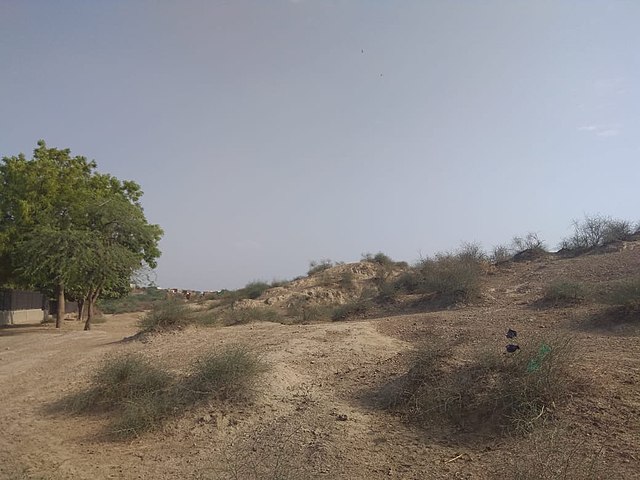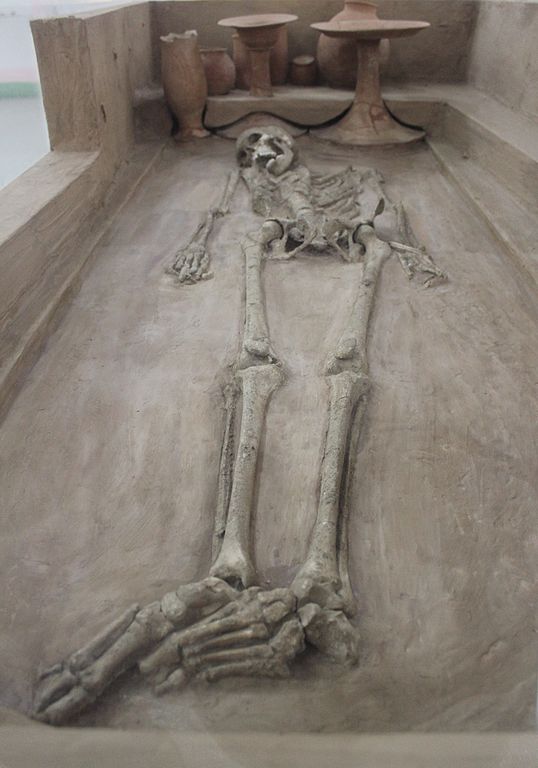
| RAKHIGARHI
Rakhigarhi Rakhigarhi, Rakhi Garhi (Rakhi Shahpur + Rakhi Khas), is a village in Hisar District in the state of Haryana in India, situated 150 kilometers to the northwest of Delhi. It is the site of a pre-Indus Valley Civilisation settlement going back to about 6500 BCE. Later, it was also part of the mature Indus Valley Civilisation, dating to 2600-1900 BCE. The site is located in the Saraswati / Ghaggar-Hakra River plain, some 27 km from the seasonal Ghaggar river.
Rakhigarhi encompasses a set of seven mounds, and there are many more settlement mounds in the immediate vicinity. Not all of them were occupied at the same time. Depending on which mounds to include, the estimates of the size of Rakhigarhi have been given variously as between 80 and 550 hectares. In January 2014, the discovery of additional mounds resulted in it becoming the largest Indus Valley Civilization site, overtaking Mohenjodaro (300 hectares) by almost 50 hectares, resulting in almost 350 hectares.
The size and uniqueness of Rakhigarhi has drawn much attention of archaeologists all over the world. It is nearer to Delhi than other major sites, indicating the spread of the Indus Valley Civilization east across North India. Much of the area is yet to be excavated and published. Another related site in the area is Mitathal, which is still awaiting excavation.
In May 2012, the Global Heritage Fund, declared Rakhigarhi one of the ten most endangered heritage sites in Asia. A study by the Sunday Times, found that the site is not being looked after, the iron boundary wall is broken, and villagers sell the artefacts they dig out of the site and parts of site are now being encroached by private houses.
Location
:
There are many other important archaeological sites in this area, in the old river valley to the east of the Ghaggar Plain. Among them are Kalibangan, Kunal, Haryana, Balu, Haryana, Bhirrana, and Banawali.
According to Jane McIntosh, Rakhigarhi is located in the valley of the prehistoric Drishadvati River that originated in Siwalik Hills. Chautang is a tributary of Sarsuti river which in turn is tributary of Ghaggar river.
Lohari Ragho is a smaller site nearby.
Excavations :
In 1963, Archaeological Survey of India (ASI) began excavations at this site, and, though little has been published about the excavations. Further excavations were conducted the ASI headed by the archaeologist, Amarendra Nath, between 1997 and 2000. [note 1] The more recent and substantial excavations have been performed by Prof. Vasant Shinde, the then Vice Chancellor and an archaeologist from the Deccan College, Pune, Maharashtra.
The ASI's detailed excavation of the site revealed the size of the lost city and recovered numerous artefacts, some over 5,000 years old. Rakhigarhi was occupied at Early Harappan times. Evidence of paved roads, drainage system, large rainwater collection, storage system, terracotta bricks, statue production, and skilled working of bronze and precious metals have been uncovered.[citation needed] Jewellery, including bangles made from terracotta, conch shells, gold, and semi-precious stones, have also been found.
There are nine mounds in Rakhigarhi which are named RGR-1 to RGR-9, of which RGR-5 is thickly populated by establishment of Rakhishahpur village and is not available for excavations. RGR-1 to RGR-3, RGR6 to RGR9 and some part of RGR-4 are available for excavations.
Dating
:
Area
:
Many scholars, including Raymond Allchin and Rita P. Wright believe it to be between 80 hectares and 100+ hectares in area. Furthermore, Possehl did not believe that all mounds in Rakhigarhi belong to the same Indus Valley settlement, stating, "RGR-6, a Sothi-Siswal site known as Arda, was probably a separate settlement."
With new findings however of two additional mounds of 25 hectares each in 2014-15 during joint excavations conducted by the Haryana Archaeological Department, Deccan College Post-Graduate and Research Institute and Seoul National University, the site has now been found much larger to be over 350 hectares (3.5 km2), making it the largest Indus Valley Civilization site.
Discoveries :
A skeleton from Rakhigarhi on display in the National Museum Digging so far reveals a well planned city with 1.92 m wide roads, a bit wider than in Kalibangan. The pottery is similar to Kalibangan and Banawali. Pits surrounded by walls have been found, which are thought to be for sacrificial or some religious ceremonies. There are brick lined drains to handle sewage from the houses. Terracotta statues, weights, bronze artefacts, comb, copper fish hooks, needles and terracotta seals have also been found. A bronze vessel has been found which is decorated with gold and silver. A gold foundry with about 3000 unpolished semi-precious stones has been found. Many tools used for polishing these stones and a furnace were found there. A burial site has been found with 11 skeletons, with their heads in the north direction. Near the heads of these skeletons, utensils for everyday use were kept. The three female skeletons have shell bangles on their left wrists. Near one female skeleton, a gold armlet has been found. In addition semi precious stones have been found lying near the head, suggesting that they were part of some sort of necklace.
In April 2015, four complete human skeletons were excavated from mound RGR-7. These skeletons belonged to two male adults, one female adult and one child. Pottery with grains of food as well as shell bangles were found around these skeletons.
As the skeletons were excavated scientifically without any contamination, archaeologists think that with the help of latest technology on these skeletons and DNA obtained, it is possible to determine how Harappans looked like 4500 years ago. DNA tests have been carried out on a single skeleton. Results announced in September 2018 and a paper published in cell magazine show that the dna did not include any traces of either the steppe ancestry or the Iranian ancestry, in line with the Aryan migration theory, which says that Indo-Aryans migrated into India after the Harappan times.
Fire altars and apsidal structures were revealed in Rakhigarhi.
Hunting tools like copper hafts and fish hooks have been found here. Presence of various toys like mini wheels, miniature lids, sling balls, animal figurines indicates a prevalence of toy culture. Signs of flourishing trade can be seen by the excavation of stamps, jewelry and 'chert' weights. Weights found here are similar to weights found at many other IVC sites confirming presence of standardized weight systems.
Cotton cloth traces preserved on silver or bronze objects were known from Rakhigarhi, Chanhudaro and Harappa. An impressive number of stamps seals were also found at this site.
Cemetery
:
So far 53 burial sites with 46 skeletons have been discovered. Anthropological examination done on 37 skeletons revealed 17 to be of adults, 8 to be of subadults while the age of 12 skeletons could not be verified. Sex detection of 17 skeletons was successful out of which 7 were male and 10 female skeletons. Most of the burials were typical burials with skeletons in a supine position. Atypical burials had skeletons in a prone position. Some graves are just pits while some are brick lined and contain pottery. Some of them also had votive pots with Animal remains symbolizing offerings to the dead. Bone remains of secondary burials were not charred hence ruling out the possibility of cremation practices. While these burials retained many of the Harappan features, group burials and prone position burials are distinct. Paleo-parasitical studies and DNA analysis to determine the lineage is being undertaken.
Parasite eggs which were once existed in the stomach of those buried were found in the burial sites along with human skeletons. Analysis of Human aDNA obtained from human bones as well as analysis of parasite and animal DNA will be done to assert origins of these people.
Granary
:
Museum
:
There is also Haryana Rural Antique Museum 60 km away, which is maintained by CCS HAU in its Gandhi Bhawan, exhibits evolution of agriculture and vanishing antiques. Jahaj Kothi Museum, named after George Thomas, is located inside Firoz Shah Palace Complex and maintained by Archaeological Survey of India.
Source :
https://en.wikipedia.org/ |

